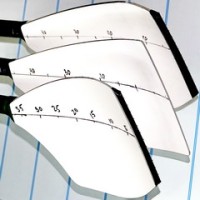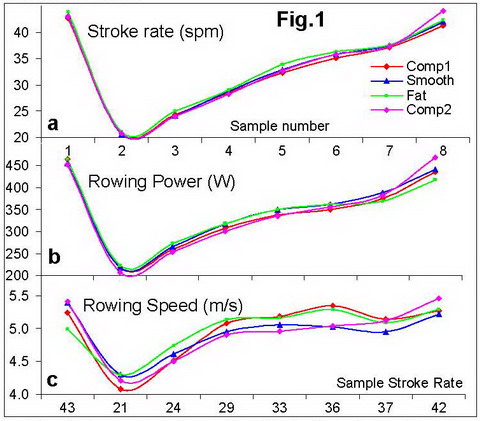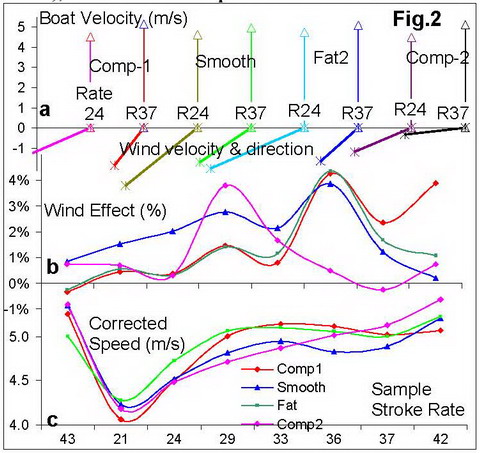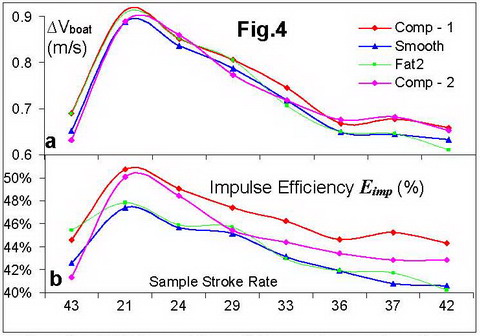Comparison of blade types

Further experimentation to determine the most efficient blade type was recently conducted, in which testing was done in a LM2x. The boat was equipped with the BioRow system, and three sets of Concept2 Skinny sculls were identically instrumented and calibrated: Smoothie blades (88/288cm inboard/oar length), Fat2 (88/281cm) and Comps (88/288cm). The standard 2km step-test protocol (8 samples at 20-40spm, RBN 2013/04) was repeated with each blade type during a morning session at Dorney Lake, followed by an additional run with the Comps in the afternoon session.

The tests were performed well: stroke rates and rowing power were consistent across all runs (Fig.1). Rowing speed measured with GPS (c) and averaged over all 8 samples was the fastest with the Fat2 blades (6:40.0 projected time for 2km) a small margin over Comps-1st run (6:41.3), followed by Comps-2nd run (6:44.0) and the slowest with the Smoothies (6:44.9). However, the Comps were significantly faster at racing stroke rates (37spm: Comp-1 – 6:28.9, Comp-2 – 6:30.6, Fat2 – 6:33.2, Smooth – 6:43.9), while Fat2 blades performed better at low rates.

The wind speed and direction (cross-tail during testing) were measured with the BioRow wind-meter mounted on the bow canvas of the boat, allowing for calculation of wind effect using Klaus Filter’s data (RBN 2009/12). A corrected rowing speed was derived, which can be interpreted as the speed with no wind conditions. Fig.2 (a) shows wind speed and direction relative to the boat velocity, (b) - wind effect (positive values indicate wind increased boat speed) and (c) - rowing speed corrected for the wind. Average corrected speed was also the fastest with Fat2 (6:45.4), slower with Comps (6.48.4 and 6:48.2) and the slowest with Smooth (6:52.4). Fat2 blades were the most efficient at low stroke rates 20-24spm, while Comps performed slightly better at racing rates 36-37spm.
Blade efficiency (Fig.3) shows the amount of energy wasted on the blade slippage in the water, and as expected, it was the highest in the Fat2 - the blades with the biggest surface area. Conversely, the Comps waste less energy on the blade rotation in the water (RBN 2021/11), so the overall efficiency was very similar with Fat2. At low rates, Fat2 had less slippage and were more efficient, but at higher rates the faster blade rotation in the water would increase its wasted energy by a cubic factor, so the smaller Comps wasted less energy here and work better.

The above findings were confirmed by analysis of the increase in boat velocity ∆Vboat during the drive (Fig.4). Earlier, it was found that this method doesn’t work for technique comparison between various rowers/crews (RBN 2019/04-5), but it works for blade comparison within the same crew.

Impulse Efficiency Eimp of the rowing system (b) was calculated as the ratio of impulse Jv derived from the velocity gain ∆V and the system mass M - to the impulse JF of the blade propulsive force Fpr during the drive time t:
Eimp = Jv / JF = ∆V M / Σ(Fpr ∆t)
Using the analysis of the velocity gain and impulse efficiency, the Comp blade shape was found to be the most efficient of the three studied.
©2022 Dr. Valery Kleshnev www.biorow.com



